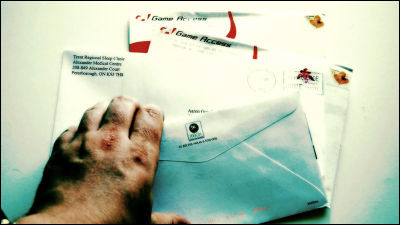An episode about how a life hack using a receipt printer helped people overcome their ADHD procrastination problems

There are probably some people who can keep playing games and social media, but keep putting off work tasks and daily housework.
A receipt printer cured my procrastination [ADHD]
https://www.laurieherault.com/articles/a-thermal-receipt-printer-cured-my-procrastination
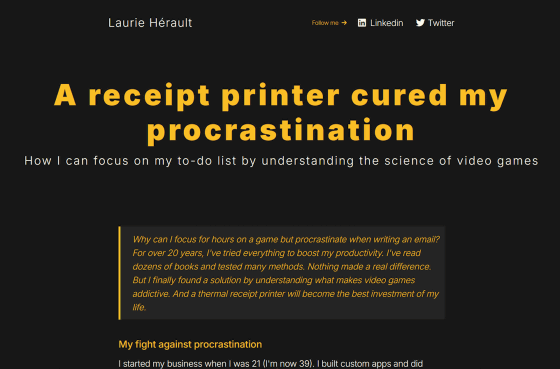
◆Why are games addictive?
He started his own business at the age of 21 and has been involved in developing custom apps and consulting on POS tools, but for many years he has struggled with procrastination problems linked to his ADHD symptoms. He relied on stress from clients and financial pressure to get things done, but this approach came at the cost of burnout and company bankruptcy.
While struggling with procrastination, Elo noticed that he could somehow stay engrossed in video games for hours on end. So Elo thought that if he could concentrate on a game, his brain could also concentrate on other tasks, and he began to think about why games are so addictive and how to apply game mechanics to tasks that are difficult to complete.
First, Elo explains the addictive nature of games by using first-person shooter (FPS) games as an example. FPS games, in which you shoot down opponents with various types of guns, are made up of a simple loop (game loop) of 'aim' → 'fire' → 'hit or miss.' The result of 'hit' or 'miss' is instantly fed back to you through sound and images. Below is a simple diagram of an FPS game loop.
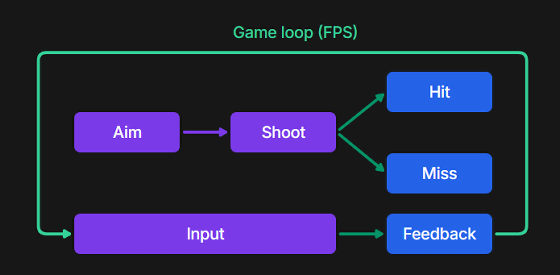
To make a game addictive, the game loop needs to repeat frequently and provide strong feedback. For example, imagine an FPS game where you only encounter an enemy once every 30 minutes, and you can see how important it is for the game loop to repeat frequently.
In addition, game feedback has evolved significantly over time. Whereas in early games it was simply 'blood splattering when a bullet hits an enemy,' in modern games it has become much more diverse, with 'the crosshairs on the aiming line changing momentarily to indicate a hit,' 'damage numbers appearing above the enemy's head,' 'sound effects being played,' 'enemy death animations being played,' 'a progress bar moving forward,' 'new skills being unlocked,' and 'random rewards being awarded.'
In addition, a game may have multiple game loops, such as 'treasure chests that randomly give you equipment for your character,' 'gacha that gives you new characters,' 'side missions that give you various rewards,' and other feedback in addition to the main game elements.
In addition, there are various factors that influence whether a game loop is addictive, such as 'the type of game is something you personally enjoy,' 'the difficulty level is suited to your skill level,' and 'it's easy to start playing the game.'
All these factors combine to give us a small hit of dopamine every time we play the game loop, which helps put us into a continuous flow state, where we are able to fully focus on the task at hand, lose track of time, and handle complex tasks more easily, Erow claims.

Mr. Elo summarizes the important points of addictive games as follows: If you can incorporate these elements into task management, tasks such as work and housework can be made as addictive as games.
- The game loop is repeated frequently
- Strong feedback from the loop
- Easy to start even if you have low motivation
How to apply a game loop to a task
Real-world tasks can also be thought of as a kind of game loop, but the important thing here is to have as many game loops as possible in a day. For example, if you take the task of 'cleaning the house', you can break this task down into smaller tasks such as 'clean the kitchen', 'clean the workroom', and 'clean the bedroom'.
But if each of these tasks takes 20 minutes, totaling an hour for all three, then you're only getting three loops in that hour. And when you think each task will take 20 minutes, you're more likely to procrastinate because you're reluctant to start.
Therefore, Mr. Elo decided to further break down the task of 'cleaning the kitchen' into 'washing dishes,' 'wiping the counter,' 'wiping the floor,' 'collecting trash,' etc. By dividing each task into microtasks that take about 2 to 5 minutes to complete, the effort required to complete the task is reduced as much as possible and feedback is given immediately.

How to improve feedback
When applying the game loop to real-world tasks, it is important to get proper feedback. Elo came up with a method to write down each task on a sticky note, and when the task is completed, roll up the sticky note and put it in a clear jar.
This allows users to receive feedback each time they complete a task, such as the feel of rolling up a sticky note, the sound made when rolling up a sticky note, and the rolled up sticky notes accumulating in a transparent jar to visualize their progress.
'The key point is that writing a task on a sticky note makes it more real. It's no longer just words on a screen. When you can actually see it in front of you, it makes it harder to procrastinate,' says Erow.
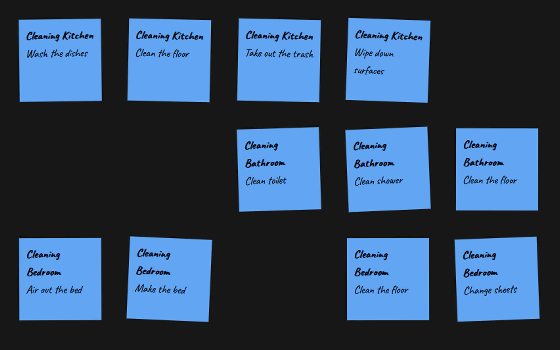
How to make the task game loop a habit
To make a system that incorporates game loops into various tasks a habit, it is good to start by making simple routines into tasks. Like in RPGs, the first enemy should be as weak as possible, which will give you a boost to challenge stronger enemies later.
In the case of Mr. Elo, the first task he does every morning is to make coffee, followed by simple tasks such as 'entering text for one minute to measure typing speed' and 'practicing keyboard shortcuts for one minute.' By completing simple tasks of about 10 sticky notes from the time he wakes up in the morning until before work, he is more motivated for the day and it becomes easier to continue working afterwards. Also, if you prepare sticky notes with the tasks for the next morning the night before, the next morning will be easier.
To incorporate a sticky note task game loop into your daily routine, it's important to have some flexibility. If you can start your day with a good game loop, you may be able to keep up with the momentum and proceed without sticky notes for the rest of your work. If your concentration is sustained, you don't need to make sticky notes, but if you find yourself procrastinating on tasks that aren't on sticky notes, it's a good idea to take a few minutes to focus and write down the next 3 to 5 tasks on sticky notes.
You may also have a big task that has been piling up for months, such as 'processing thousands of emails in your inbox.' In that case, it's difficult to process everything in one day, so it's better to start little by little, such as 'processing new emails for that day' or 'processing only x number of old emails.' Mr. Elo advised.
This method can be done even if you don't have sticky notes or a suitable jar, as long as you have some paper and some kind of container. 'You've read dozens of articles about productivity, procrastination, and efficiency, and watched countless YouTube videos. Now, take action now! No more excuses,' says Elo. 'Continue the test for a few weeks. Think of it like going to the gym. You won't become a bodybuilder with huge muscles on the first training session. Make this system a habit!' he says.

◆Introduction of receipt printer
This method worked better than any other system Elo had tried, but there was one big problem: writing down tasks on dozens of sticky notes every day was a pain. On days when he felt lazy, he couldn't write on the sticky notes, and his productivity plummeted.
One day, Mr. Elo came across a post on the overseas bulletin board Reddit that said, 'I use a receipt printer to print my daily tasks.' In response, Mr. Elo decided to introduce a receipt printer to his own task management system.
A receipt printer can easily and quickly print dozens of tasks a day, and automatically cut them to the appropriate length. In addition, a thermal receipt printer like
Mr. Ello created an app to print out daily tasks, created task lists for each day of the week, and started printing out routines that he hadn't written on sticky notes before. As a result, he says he was able to maintain consistency in his work, which significantly increased his productivity and prevented him from missing any tasks.
At the time of writing, Mr. Elo's task management environment looks like the picture below.
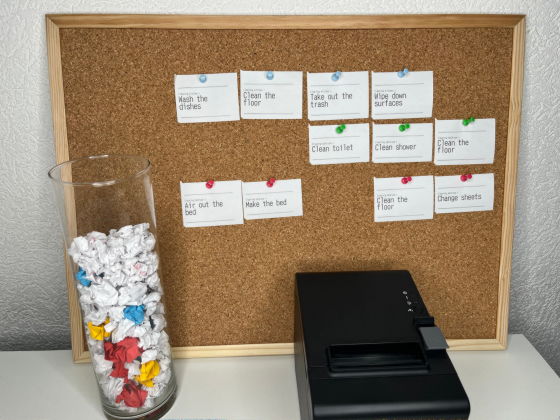
'This combination of this method, printer, and app has really changed my life over the last few months,' said Elo. 'My productivity is now stable, which is a huge daily win for me as someone with ADHD. I'm not exaggerating when I say I've doubled or tripled my productivity. Of course, there were days before I used this system when I was very productive, but there were also days when I barely got any meaningful work done. Those unproductive days have completely disappeared from my life.'
Related Posts:
in Note, Posted by log1h_ik

